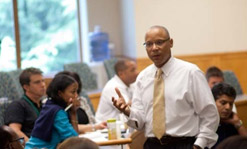GeirHeads Technology Conference
Topics: Apps Big Data / Analytics Operations Products / Services Social Supply Chain
geirheads_technology_conference_2013  The Technology Club at the Tuck School of Business at Dartmouth, in partnership with Tuck’s Center for Digital Strategies, convened the GeirHeads Technology Conference on Friday, November 1st. The Conference was an opportunity for an open dialogue between students, professors and industry experts. The center would like to thank our friend and colleague, Geir Ramleth of GeirHeads, for his generous support of this conference.
The Technology Club at the Tuck School of Business at Dartmouth, in partnership with Tuck’s Center for Digital Strategies, convened the GeirHeads Technology Conference on Friday, November 1st. The Conference was an opportunity for an open dialogue between students, professors and industry experts. The center would like to thank our friend and colleague, Geir Ramleth of GeirHeads, for his generous support of this conference.
High Tech Shopping & the Future of Retail
1pm– 2:15pm: The Shopper Experience
Moderated by Professor Steve Kahl, featuring:
Andres Bilbao, Co-Founder, Grability
Nathan Sharp, Co-Founder, Nifti
2:25pm – 3:25pm: From Main Street to MainStreet.com
Moderated by Professor Praveen Kopalle, featuring:
Dave Gilbertson, VP & GM, SaveLocal Business Unit, Constant Contact
3:45pm – 5pm: Omni-Channel Retailing & Industry Outlook
Moderated by Professor Andrew King, featuring:
Vinod Atulya Saxena, Senior Manager, Deloitte Digital
Tim Hood, Global VP Strategic Technologies, Chief Solution Architect Retail Industry, SAP
Perspectives from the Students
Shopper Experience
by Isabella Liu T’15
On the Shopper Experience panel at the 2013 GeirHeads Technology Conference, Nathan Sharp (T’12) and Andres Bilbao (T’13) shared with the Tuck and Dartmouth communities their frontline experiences of starting companies in e-commerce. Nathan Sharp is the founder and CEO of Nifti, a web and app service backed by Google Ventures that helps shoppers track product prices. Andres Bilbao is one of the founders of Grability.com, an e-commerce platform that enables in-store shopping experiences over mobile. Steven Kahl, an Associate Professor at Tuck, moderated the panel and posed questions that touched on every stage of a startup’s lifecycle.
Tech today is awash in buzzwords and trends that are accepted as dogma. Through anecdotes, Sharp and Bilbao provide a more nuanced view of many of these topics, sometimes challenging them and other times confirming them while offering their own explanations.
When trying to design a product, both Sharp and Bilbao advised would-be entrepreneurs to rely on common sense over being too data-driven. In an unusual split from most in tech, Sharp warned against employing the Lean Startup methodology for industries like e-commerce, where the product has been commoditized and existing players have polished interfaces.
Sharp and Bilbao agreed that the biggest trend in e-commerce is the ascendance of mobile and consumers’ increasing comfort around shopping on mobile. The two Tuck alums recommended having a mobile strategy and responsive design that embrace this shift in consumer behavior, but cautioned against startup ideas that try to change consumer habits as part of the business. Sharp explained, “It is so much easier to create a new technology rather than a new consumer behavior.”
Finally, on raising capital, Andres Bilbao cited the recent spree of transactions in retail, explaining it is not hard to get funding given the amount of interest in the space. Nathan Sharp added that the Series A crunch is a result of investors realizing that returns come from seed funding.
GeirHead Technology Conference 2013 Fireside Chat
By Steve Tsui T’15
The theme of the fireside chat at the GeirHead Technology Conference this year, moderated by Professor Praveen Kopalle, was “From Main Street to Mainstreet.com.” Dave Gilbertson (T’05), the VP and GM of Save Local at Constant Contact, was our keynote speaker at this event. He spoke at length about the opportunities and challenges faced by local businesses and how technology fits into the big picture.
Dave surprised us by stating that a lot of local retail businesses are already very sophisticated in that they understand that recurring purchases are driven by customer experience. Instead of using social media as a new advertising platform, the most successful local businesses are using social media (such as Facebook) to connect and communicate with customers, thereby reinforcing their brand and deepen the customers’ involvement. By doing this, Dave suggested that current customers will help local business by raising awareness through word of mouth. To this end, Dave also suggests that deep and infrequent discounts for loyal customers are far more effective in driving sales than shallow and frequent discounts. Fundamentally, Dave believes that technology can help push local businesses to be more niche so that they are the experts in their businesses.
One of the most interesting insights that Dave presented was that value that data provides to local businesses is fundamentally different from larger business. He observed that most successful local businesses already understand their customer bases intimately (i.e., who their best customers are, etc.) and that data might be useful in understanding how the customers interact with their marketing (e.g., those who claimed deals but didn’t come to the stores and the timing of their last visit, etc.). These interactions will generate insights that will allow local businesses to devise highly effective and targeted promotions.
In addition, Dave also shared a number of interesting statistics:
- 85% of local consumer facing businesses are using FB
- 50% of local businesses have website (since 2006, constant)
- The most effective local businesses are spending only 15 minutes per day on social media
- Overlap between individual local businesses’ email lists is only about 2%
Finally, Dave also agreed that mobile is a key area for local businesses to explore. However, there are still many challenges, such as low conversion rate, unreliable reception, and an overwhelming amount of data, that must be tackled before local businesses can leverage the mobile space.
Omnichannel Panel
By Sandy Chen T’15
The last panel of the 2013 GeirHead Technology Conference, moderated by Professor Andrew King, was entitled “Omni-Channel Retailing & Industry Outlook”. Vinod Atulya Saxena from Deloitte Consulting and Tim Hood from SAP provided us with a view of the industry’s outlook as well as the challenges facing many retailers today as they look to transition to Omni-channel.
Tim Hood said it best, that “Power is now in the hands of the consumer”, whereas in the past, if you built it, they would come. With the advent of technology, consumers can easily conduct their own research to make a purchasing decision. The consumer path is no longer channel specific and retailers must fulfill this need by becoming seamless between channels.
Most retailers are not equipped to address this pivot to the consumer. The legacy systems used to manage SKUs, sales forecasts, margin, inventory, and other data are all built around the individual items sold by a retailer. Each channel has its own system, with different pools of inventory and in some cases, different SKU information. However, as the marketing and sales efforts become increasingly consumer-centric and seamless across the brand, retailers must invest in the infrastructure and processes to create a consistent customer experience across all channels. This change sounds easier to execute than it really is.
As a former employee of a high-end retailer transitioning from Multi-channel to Omni-channel, this was a salient topic for me. I recall our difficulty to align our two separate systems and to check every piece of data to ensure that we matched. It was not unusual to find differing price points or even differences in assortment online vs. in-store (these differences were often found manually). I often dreamed of a comprehensive system that would store all information for both channels under one infrastructure; however, the ROI argument was challenging to make, especially if the current system was “good enough”.
In addition to the internal technological trends Tim highlighted, Vinod Atulya Saxena provided some insight on consumer-facing Omni-channel trends, such as the use of digital displays, virtual tools and communities (on e-commerce sites), in-store apps, and the gamification of Retail. Retailers like Sephora are leaders in providing a digital in-store experience similar to the experience of shopping at home on iPads. Use of mobile point-of-sale systems, self-checkout, etc. will also help retailers create a more engaging experience for consumers in brick-and-mortar.
While it will be difficult for Retailers to transition towards a more Omni-channel infrastructure, it is clear that the change will be inevitable and necessary for the retailer to survive and thrive.








